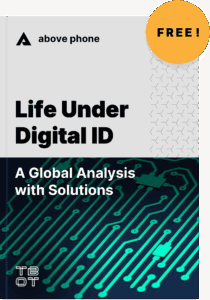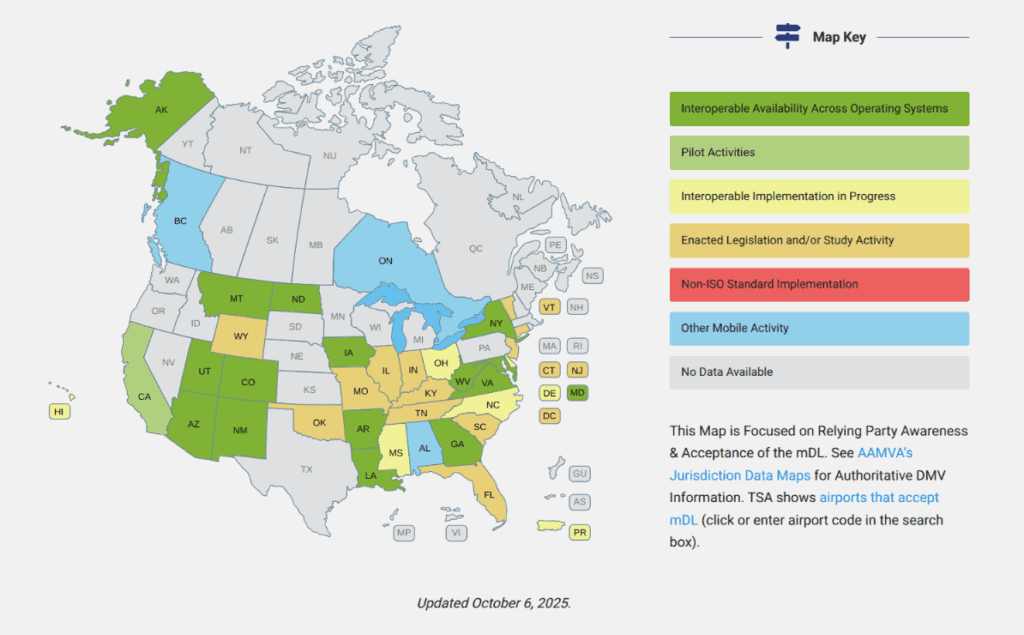In this piece, Hakeem Anwar takes an in-depth look at digital ID systems globally: timelines, proxy mandates, privacy risks, identity theft, progression stages, US specifics, and opt-out solutions.
Note: Above Phone and Peak have an affiliate relationship. Hakeem’s team has been very busy putting together a comprehensive report that goes in-depth into this topic, which is now available for free. You may sign up to receive a free download link by clicking here. The “short” version is below!
Digital identity systems are rapidly becoming the de facto gateway to citizenship, commerce, and even movement—all working together to create a single point of control that can be used to digitally erase or marginalize anyone who opposes it and to punish rulebreakers.
In taking a look at digital ID pilot programs around the world, we see that most countries have a digital ID program in development or available to the public. We expect national ID apps (either provided by the government or through big tech apps) to be available in the next two years. After this, the push for adoption will be made over the next five years towards 2030. Within a decade, legacy means of identification will be made largely obsolete, forcing reliance on regional and controllable digital credentials for everything from travel to trade.
Interestingly, lawmakers in the EU and Australia have written into law that their digital ID will always be voluntary.
Section 57 of the EU Regulation establishing the European Identity Digital Framework clearly states, “Users should be under no obligation to use a European Digital Identity Wallet to access private services and should not be restricted or hindered in their access to services on the grounds that they do not use a European Digital Identity Wallet.”
But can we trust them?
Digital ID Mandates Happen By Proxy
India’s Digital ID system, Aadhar, started off with the goal of being “”voluntary.”” The Supreme Court ruled that people could not be discriminated against for lack of a digital ID.
However, Aadhar has enrolled more than one billion Indians since 2009 through mandate by proxy, the country compelling the use of the ID:
- Several major banks imposed Aadhar requirements to open new accounts (despite an Apex court ruling).
- Mobile phone operators demanded that customers link their Aadhar and mobile numbers together—or risk disconnection.
- Larger international freight services required senders to send them a copy of Aadhar.
- India’s largest e-commerce system and digital wallet, Paytm, required Aadhar for KYC (know-your-customer).
- Landlords throughout the country have insisted on Aadhar to qualify as a renter.
Those without a digital ID in India must be willing to live unbanked, without a phone, and potentially without a home. The system is inherently exclusionary—if you don’t play along, you’re excluded from society.
And while some of us may be prepared to make that choice, the vast majority of people are not and are nowhere near educated enough on the topic in order to make an informed choice.
Whether we like it or not, these restrictions are coming. And they’ll be here sooner than most of us could have imagined. In fact, Keir Starmer recently announced that digital ID will be required to work in the United Kingdom by 2029. That’s just over three years away.
Planning to travel to the EU anytime soon? You may need to reconsider your plans with the EU requiring foreigners to go through biometric collection on entry.
Life Under Digital ID: A Global Analysis with Solutions
My team at Above is just about to release a new report outlining digital ID schemes in every corner of the world. Through our research, we have found only a handful of places around the world not planning a digital ID program.

These places are in remote lands (think Amazon Jungle) or are working on an electronic ID instead (precursor to digital ID).
Whether these digital IDs will be explicitly mandatory or whether they are mandated by proxy, these schemes will soon enter your daily life no matter where you live—or plan to live.
Our new report will demystify the underlying technology behind digital ID and explain it in easy-to-understand terms. Man fears the unknown. Therefore, we must seek to fully understand digital ID, eliminate our fears, and have productive conversations with our communities on the very real risks to our privacy and our freedom.
The report also analyzes the digital ID schemes in different areas of the world, laying out timelines, mechanisms of control, and interrelated aspects such as health passes, internet controls, and digital currencies.
But most importantly, we take a look at the solutions that are currently available to those who simply want a say in their digital identity.
Our new report is now available for download on Above’s website. Sign up for the download, and it’ll be in your inbox today! In this article, we’ll explore some of the overarching concerns, statuses and timelines, and a preview of solutions you can consider right now.
The Spider Web of Trust
The earliest pioneers of digital identity were technology companies providing enterprise identity services like Microsoft and IBM. Today, the digital ID ecosystem is an evolving web of technologies and organizations, from non-profit to government to the private sector.
Many powerful global organizations are behind the push for digital ID, including:
- The World Bank—Leading the ID4D initiative, establishing digital identity in developing countries.
- The United Nations—Sustainable Development Goal 16.9 aims to havea digital legal identity for all by 2030.
- ID2020—An NGO dedicated to carrying out the UN’s SDG 16.9. ID2020 holds yearly summits to develop standards and is currently running a pilot program in Bangladesh to track digital ID for things like births and immunizations.
- The Bill & Melinda Gates Foundation—Invests in digital ID systems for developing countries.
If these companies and organizations all have a hand in the creation, rollout, and promotion of digital ID, it isn’t a stretch to question if they will have access to the wealth of data that digital ID would collect on billions of people around the world.
Privacy Risks
Digital ID programs have reported that they will use features to minimize the data shared when using your digital ID. However, it will take years to implement these privacy features, and consumers will never be given access to the back-end source code for these systems; there will be no way to certify the data being shared.
Once you’re in the digital ID system, you can’t get out.
Your Life Mapped Out
As more verifying bodies come online through retail, payment, and online providers, the information generated by interactions can easily be shared back to the issuer.
The associative nature of digital credentials means that a life graph can be built of every ID holder that details every single interaction with the digital ID system. We know that big tech, corporate social media, etc., build user profiles of us based on our behavior (even those who don’t have accounts). Digital ID takes this concept to an entirely different level that is difficult to even comprehend.
Digital Identity Theft
Before verification methods like zero-knowledge proofs become widely available (likely years down the line), it will be trivial for someone to steal your digital ID when you share it with them (i.e. a liquor store or a concert venue).
This is because your digital ID arrives at the recipient unencrypted; it’s all they need to impersonate you.
While this threat can be minimized, it depends entirely on the entities developing the wallet and verification software.
Stages of Digital ID Progression
Through our study of global digital ID programs, we have observed a pattern that most nations follow on the path to full adoption. This involves various administrative, legislative, and technical steps that increase in authoritarian nature as they progress.
The first stages focus on convenience and efficiency, while the final stages are our prediction of the coming shift towards additional surveillance and control.
Most countries are in the nice carrot phase before the stick, much like the free donuts and fries during the COVID-19 vaccine rollout before harsher consequences.
Before there can be a digital ID, there must be an electronic ID, ideally backed by biometrics. Countries use strategies like requiring biometrics upon ID renewal (happening in states in the US and Canada) to build this foundation. Low-income countries are improving their electronic ID programs before digital ID (funded and driven by the World Bank’s ID4D initiative).
Once an electronic ID with biometrics becomes pervasive, digital ID programs can automatically issue identities for everyone already in their system; this is a common practice (Italy, Denmark). Imagine tens of millions of identities being created, all at once.
The ID is already created, so now governments must convince the individual to download the app and use the digital ID.
In this phase, the focus is on adoption, with the rollout of things to make the digital ID convenient and able to be used in more places, like integrating with efficient payment apps and demanding that companies accept the digital ID as a form of identification.
It’s also common at this stage for the ID to be required for welfare and social security.
Finally, for those holdouts comes the stick phase, where natural rights like the ability to drive, travel, and exchange are taken away and put behind a digital ID requirement.
We go into greater depth about all these stages in the full report.
United States Digital ID Analysis
Even though the United States does not have firm standards or a timeline for digital ID, the government is doing everything correctly for when a future program arrives. After years of delays, the Department of Homeland Security (DHS) recommended enforcing REAL IDs for domestic air travel starting May 2025. In 2024, DHS estimated that there were 110 million noncompliant IDs—roughly a third of the US population.
While REAL IDs do not necessitate a digital component, several high-population states require biometrics in order to renew an ID, including California, Texas, Illinois, and Washington.
Mobile driver’s licenses (mDL) are the most popular form of digital ID in the US. These are offered through mobile wallets provided by American technology companies like Apple, Google, and Samsung. Recipients must go through a biometric verification process by taking a selfie and uploading pictures of their driver’s license to enroll.
The Secure Technology Alliance is tracking the progress of state mDL interoperability, with the goal of all states using the ISO/IEC 18013-5 standard. Twelve states have already reached this goal, with another 14 working to implement the standard.

(Source)
The way states distribute these ID is mixed. According to the TSA website, Apple Wallet leads the pack with 11 states supported, Google Wallet with 9 states, and Samsung with 6 states. Nine states have built their own proprietary mDL apps.
Thus far, adoption for these mDL programs is fairly low. Most states range from 1% to 6% conversion, with the state of Arizona topping out at 15%. The bad news is that the personal records of Americans are being centralized at a rapid pace.
The January 2025 Trump Executive Order “Stopping Waste, Fraud, and Abuse by Eliminating Information Silos” directed federal and state agencies to open their data up to each other. Simultaneously, big data companies like Palantir have become popular with federal and state agencies. Palantir’s big data software can create digital representations of the real world, down to the individual level.
Any action connected to a digital ID could potentially be logged and added to a centralized surveillance system. Palantir just so happens to have the best product in town, and given their extensive contracts with Western militaries, they are well-positioned to hold this secret database.
Other Countries
For this limited preview of our report, we have shared exclusive details on the U.S. Digital ID Climate. If you’d like to learn more about the situation in Europe, the UK, Canada, and the rest of the world, sign up to download the full report.
Let’s Talk Solutions
The problem of digital ID is a big one, and it’s not going away anytime soon. Those who plan to object to digital ID must make themselves familiar with the various stages outlined above, as it will be important to object to and opt out of each of these in the lead-up to complete digital ID. This includes electronic IDs and the collection of biometrics. It isn’t a stretch to expect that to fully object, those who choose to do so must be prepared to sacrifice some goods and services.
Now is the time to draw your line in the sand. How uncomfortable are you willing to get? How prepared are you for what you may lose access to? If we don’t think about this now, digital ID will slowly (or quickly) creep into our lives through the stages we’ve outlined here. And before you know it, you just may need it to return to your home, access your money, receive medical care, or even survive—unless you’ve prepared for this ahead of time.
Educate yourself, draw your line in the sand, and begin preparing today, if you haven’t already. Sign up to download our full report, The Future of Digital ID: A Global Analysis with Solutions.
~ Hakeem







